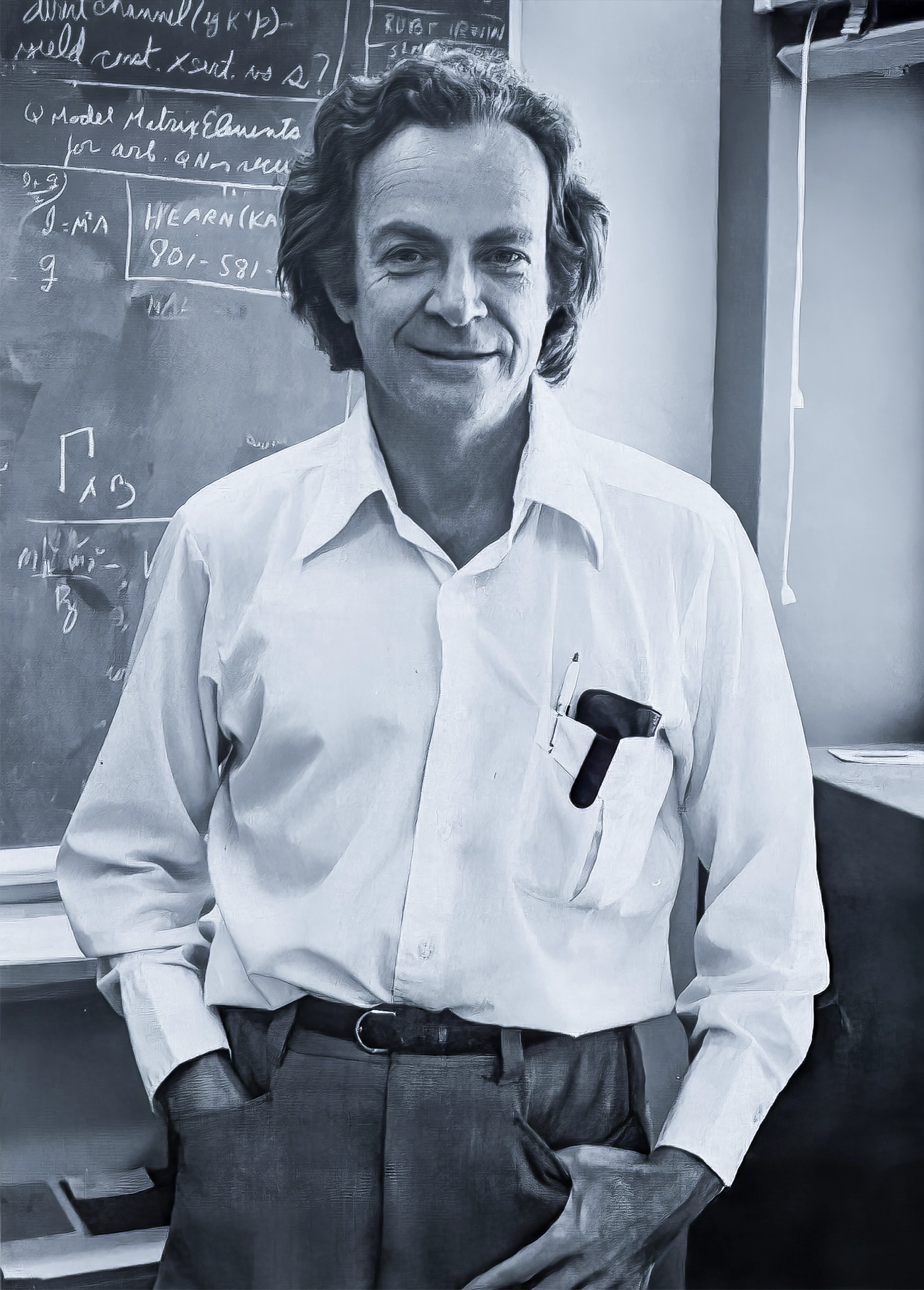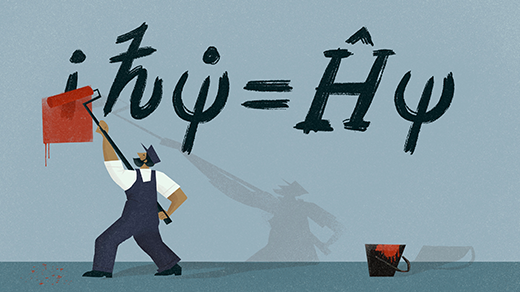Old ‘Ghost’ Theory of Quantum Gravity Makes a Comeback

A 1977 theory known as quadratic gravity was long left to languish because of its negative-energy “ghost” particle. But the ghost might not be a deal-breaker after all.
Kristina Armitage/Quanta Magazine
Introduction
The force we experience most intimately remains the most mysterious. Physicists understand how vast migrations of particles called photons light up our homes, and how swarms of “gluon” particles hold together the cores of our atoms. But they can’t say what gravity particles, if any, delight us as babies by enabling our spoons to plummet to the floor. The force of gravity has proved so difficult to account for in terms of particles that many physicists have abandoned that approach altogether. They consider the possibility that gravity — and with it, reality as a whole — might instead be made of tiny strings or other strange things.
But in one corner of the theoretical-physics world, the particle approach is staging a comeback. A growing band of physicists has been using the typical approach to particle physics, known as quantum field theory, for gravity. Although this use of the theory was long considered fatally flawed, these physicists are now finding that it works far better than their predecessors expected.
“So far there is no hint telling us that we should throw quantum field theory away; actually, it’s the opposite,” said Luca Buoninfante, a theoretical physicist at Radboud University in the Netherlands whose calculations have helped shore up the old theory. When you apply the standard quantum field theory to gravity, you don’t just get a unique theory called quadratic gravity, he said. “You also get new predictions.”
Those predictions have not yet been tested. And on purely theoretical grounds, quadratic gravity has eerie features that still spook many physicists.
But quadratic gravity enthusiasts aren’t put off by its abnormalities. On the contrary, they view these features as previously unappreciated possibilities that may be permitted by quantum field theory. Perhaps effects occasionally sneak ahead of their causes at the microscopic level, for instance. And perhaps negative-energy “ghost” particles that arise in quadratic gravity can exist safely in the equations without creating paradoxes in experiments.
Ghosts, Buoninfante said, may be “new objects that appear when we try to understand gravity and quantum field theory at a deeper level.”
More Constants, More Problems
From the moment physicists tried to fit gravity into quantum field theory (the framework they use to describe all the other fundamental forces), it was obvious the union was going to be a rocky one.
Quantum fields are rippling substances that suffuse space. A ripple in a quantum field is a particle. By exchanging streams of these particle-ripples, one object can push or pull on another, exerting a force. The electromagnetic force, for instance, is conveyed through disturbances in the electromagnetic field that we call photons.
A deeply inconvenient truth of quantum field theory is that what a field does depends on each and every one of the ripples it can conceivably support. And those ripples come in an unending number of shapes and sizes. When physicists first invented quantum field theory and tried to use it to ask questions about electrons and photons, their calculations went infinite because each term in a sum tried to account for a never-ending continuum of ever-smaller ripples. But a sum of infinite terms was no answer at all.
In the late 1940s, the physicists Richard Feynman, Julian Schwinger and Sin-Itiro Tomonaga independently hit on a workaround that would turn those endless ripples into clear answers, earning themselves a Nobel Prize. They realized that they could reexpress the unknowable, infinite-seeming parts of their calculations in terms of their net effect on two known constants that had already been measured in the lab: the electron’s mass and charge. Doing so fixed the values of the terms, after which physicists could predict anything they liked about the electromagnetic field.

Richard Feynman helped turn quantum field theory into a functioning framework.
Wikimedia Commons
This trick, known as renormalization, seemed like an algebraic hack. But over the following decades, physicists came to understand why it worked. Renormalization was a way of blurring out the smallest ripples in a field and including only their net effects. In the case of the electromagnetic field, this works because the impact of the small ripples is limited; the smaller the ripples get, the less they influence the larger ripples.
Gravity, however, works differently.
Gravity too has a field: the fabric of space-time itself. Albert Einstein, in his general theory of relativity, described gravity as a consequence of objects “falling” along curves in this space-time fabric. This gravitational field is not a rippling thing that fills space, per se, but rather a rippling thing that is space. Physicists have detected “gravitational waves” traveling through this field. And the tiniest ripples in this field cause no end of trouble.
When Feynman and a colleague by the name of Bryce DeWitt tried to renormalize gravity, they found that the tinier the space-time ripples, the more they matter. They influence the rippling of space-time at higher levels in innumerable subtle ways that can’t be summed up only in terms of a few measurable constants. The trick failed. The tiny space-time ripples refused to be blurred out.
“Everyone was concerned about this,” said John Donoghue, an expert in quantum field theory at the University of Massachusetts, Amherst. “This is the reason that quantum general relativity was considered a problem.”
Birth of Quadratic Gravity
In the mid-1970s, the late Kellogg Stelle, then a graduate student at Brandeis University, saw that there was a way — and only one way — to stop the inundation of infinities that had plagued earlier attempts to “quantize” general relativity.
General relativity can be written as an equation that has a single term representing space-time’s curvature. Apply Feynman and DeWitt’s renormalization procedure to this equation and you get one type of particle-ripple, the graviton, rippling in unignorably infinite ways.

Kellogg Stelle was a professor of physics at Imperial College London for decades until his death last month. In 1977, he developed a particle theory of gravity that’s renormalizable, but the theory’s ghost particle was off-putting.
Mateo Potts
But Stelle figured out that he could modify Einstein’s equation so that space-time more closely resembled the electromagnetic field, with ripples that became less significant as they got smaller. Their overall effects could then be captured in just a few measurable constants, analogous to the electron’s charge and mass in electromagnetism. This theory of gravity, which came to be known as quadratic gravity because it contained two new terms related to the square of the curvature, was renormalizable. It made just as much sense as electromagnetism.
“That gives you a — indefinite article — quantum theory of gravity,” said Stelle, who was a professor at Imperial College London until his death last month. “Then of course the question is: Do you like it?”
Most physicists, Stelle among them, did not.
“I was also aware that not everything was going to be hunky-dory about this,” he said during an interview in April.
The problem was that this enhanced fabric of space-time could now host three types of ripples. The first term represents the normal gravitons. But the two curvature-squared terms bring two new particles into the picture. One is inoffensive, what Stelle called a “sweet little scalar” particle. But the other is a ghoul.
An unwelcome minus sign stemming from the third term unleashes chaos. The associated particle has negative energy, so the space-time fabric actually gains energy by creating it. This means that more and more of such a particle will spontaneously appear, whipping space itself into an increasingly energetic inferno.
Worse, events involving this third particle may have a negative probability of taking place — a meaningless proposition.
Physicists call such particles ghosts and say that theories haunted by ghosts are “sick” — mathematically inconsistent.
Shortly after Stelle published his research in 1977, physicists stumbled across a healthier quantum gravity theory called supergravity. It solved a handful of problems by positing that each known elementary particle teams up with an as-yet-undiscovered “superpartner” particle. Supergravity immediately captured the attention of theoretical physicists, including Stelle. The theory would eventually merge with string theory and dominate the field for decades.
Quadratic gravity, with its ghosts and inconsistencies, couldn’t compete. Physicists paid it little attention, citing Stelle’s paper just 10 to 20 times per year.
Ghostly Revival
The theory never completely faded away, however.
Theorists returned to it here and there. Interest rose in the 2010s as string theory failed to deliver the spectacular breakthroughs its early practitioners had promised, and superpartners failed to materialize in experiments at the Large Hadron Collider.
In 2014, the Italian physicists Alberto Salvio and Alessandro Strumia wondered whether quadratic gravity could solve a puzzle that many had expected the superpartners to address. The puzzle, known as the hierarchy problem, asks why gravity seems impossibly weak compared to the other three fundamental forces. Why is there one “scale” for those forces, and a special, dramatically different one for gravity? Salvio and Strumia found that the two extra particles from Stelle’s theory could help push the two scales apart. That got them wondering whether the ghost was truly a deal-breaker.
A few years later, Damiano Anselmi of the University of Pisa found that researchers can avoid the pitfalls encountered by theories with ghosts by using alternative versions of the rules Feynman laid out for describing quantum events. “You have the impression that the last word had been said. It was just not true,” he said.

John Donoghue, an expert on quantum field theory at the University of Massachusetts, Amherst, considers quadratic gravity “a viable candidate for a theory of quantum gravity,” as he wrote in one recent paper.
Elaine Donoghue
Donoghue, who recently won the prestigious J.J. Sakurai Prize for his contributions to quantum field theory, also started studying the allegedly sick theory. Working with Gabriel Menezes, now of the University of São Paulo in Brazil, he found that in simple scenarios, the ghost particles don’t actually wreak the havoc physicists feared. They are so unstable, they tend to vanish before they have time to fire up the vacuum or manifest negative probabilities. The vacuum stayed calm, and probabilities continued to add up to 100% — an essential property known as unitarity.
“We have a few examples, which are what made me believe it,” Donoghue said. “Things everyone else would have said violated unitary don’t seem to.”
So why does the ghost seem to silently lurk, rather than actively haunting Stelle’s theory? Quadratic gravity enthusiasts have hit on a couple of overlapping ideas.
Salvio and Bob Holdom, a physicist emeritus at the University of Toronto, have independently noticed that it’s possible to tweak the final (and rather suspect) step in the calculation of probabilities in a way that guarantees they’ll always stay positive.
And Donoghue points out that even if you don’t change Feynman’s rules in the manner proposed by Anselmi, ghosts barely exist. They show up only fleetingly, over short distances. In those instants there is a heavy price to be paid, but it isn’t stability or unitarity. Rather, it’s the normally rigid ordering of cause and effect. That minus sign allows ghost particles to briefly skip backward in time, where they can influence particles that they otherwise couldn’t. In this picture, the inexorable forward flow of time that we experience would emerge as a delicate average over lots of temporally squishy micro-moments.

Gabriel Menezes of the University of São Paulo in Brazil, working with John Donoghue, has shown that ghost particles don’t lead to expected violations of unitarity.
Barbara Menezes
Understanding each of the other fundamental forces required physicists to master strange new concepts like renormalization. So, the researchers argue, perhaps ghosts (and the modified rules of quantum field theory that are needed to deal with them) are the key that will unlock gravity. And even if gravity doesn’t work this way, physicists see value in rigorously exploring the behavior of quantum field theories with ghostly minus signs. “There is something to understand there,” said Benjamin Knorr, a researcher at Radboud University who works on other gravity theories.
Much work remains to determine how compatible these proposed extensions of standard quantum field theory are with each other, and whether they will fail in more demanding situations. But for the most part, quadratic gravity researchers have stopped fearing ghosts. “Mathematically, they make sense now,” Buoninfante said.
Other theorists, however, still harbor qualms as to whether these fixes really address all the potential problems. One does not simply tinker with critical tenets of physics like causality and unitarity. “They’re working hard,” said Alessia Platania, a quantum gravity researcher at the University of Copenhagen. “But I would say it’s still open as a question.”
Layers of Reality
For quadratic gravity researchers, the uncertain work of ghost-busting is worthwhile. On top of the theory’s mathematical advantages, Stelle’s “sweet little scalar” is exactly the sort of particle (and associated quantum field) that could have driven an explosive expansion of the cosmos during the Big Bang, which many cosmologists believe set up the universe we see today. In fact, the Soviet physicist Alexei Starobinsky used quadratic gravity to formulate the first theory of that initial growth spurt, termed cosmic inflation, in 1980.
Cosmic inflation should have set off ripples in space-time that left subtle imprints on the sky. These haven’t been seen despite intense searching, ruling out several models of inflation. Recent work from Anselmi and others, however, suggests that a universe with quadratic gravity should produce ripples too small for current telescopes to detect. Next-generation observatories may be able to pick up these weak waves.

In 1980, the Russian physicist Alexei Starobinsky proposed one of the first viable models of cosmic inflation, showing that one of the particles in the quadratic gravity framework could have driven a brief exponential expansion of the early universe.
Nikolay Malakhin/Scientific Russia
“Starobinsky inflation is the only remaining one that makes sense from a quantum field theory point of view to my taste,” Donoghue said.
Through a combination of unexpectedly friendly ghosts, the growing popularity of Starobinsky inflation, and other quantum gravity theories languishing in the doldrums, quadratic gravity has grown in popularity. Stelle’s original paper has recently been accruing more than 150 citations each year.
If the ghosts can be fully vanquished and the space-time ripples from Starobinsky inflation are detected someday, what would quadratic gravity imply about reality? Opinions vary.
Clues from string theory, black hole physics and other places have led to a widespread belief that space-time should unravel into stranger stuff at some submicroscopic scale. But if quadratic gravity turns out to be the ultimate theory of gravity, then the quivering space-time fabric could persist no matter how far you zoom in. “We’re talking about a true continuum description all the way to arbitrarily small scales,” Holdom said. “Space-time forever.”
That possibility recently received a boost. Last year, Donoghue and collaborators discovered an important mathematical fact about how gravitons collide in quadratic gravity. As collisions get more intense, gravity gets weaker, making calculations easier — a phenomenon known as asymptotic freedom. Their result suggests that quadratic gravity never breaks down and could take you all the way to the deepest levels of reality. “This could allow it to be the final theory,” Donoghue said. However, he added, “I’m not convinced that this is the final theory.”
The alternative is that quadratic gravity, despite being renormalizable and asymptotically free, still isn’t a complete account of gravity.
Recall that renormalization amounts to a filter over the world that blurs out its tiniest ripples. Renormalizable theories are those in which glossing over those features doesn’t change the overall picture much. The blurry picture works well. Non-renormalizable theories are those where the blurry picture looks quite different from the sharp picture. It doesn’t work as well as you’d like because every infinitesimal detail matters. So non-renormalizable theories, like quantized general relativity, challenge physicists to understand all of reality’s layers at once.
The surprising successes of quadratic gravity hint that gravity may yet turn out to have a blurry picture that works well enough after all. Below a certain spatial scale, it may be that any complicated details — whether those are strings, loops or nothing at all — can be ignored, and you’ll still get a fully consistent theory. If that’s the case, physicists can accurately predict how gravitons collide and how the universe inflated without worrying about what’s truly going on at the smallest scales. “It may or may not be the ultimate theory,” Donoghue said. But maybe “it becomes a closed, self-consistent layer of reality.”
Stelle shared that view. He never returned to his theory himself, keeping tabs on its recent revival (which he called “agreeable”) from afar. But he came to suspect that it had some value after all. “My own reaction to it right now is, it’s a possible link,” he said, “a kind of intermediate regime.”



